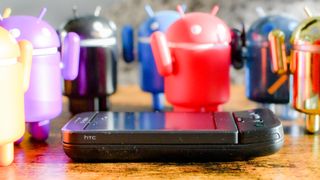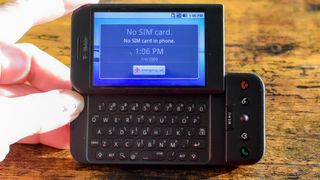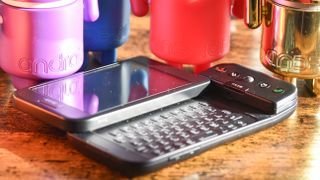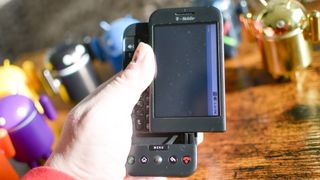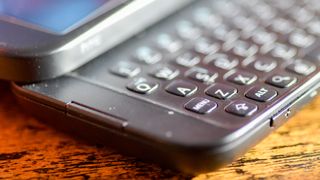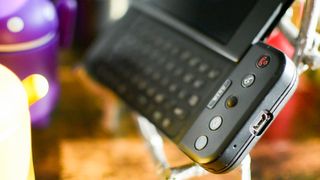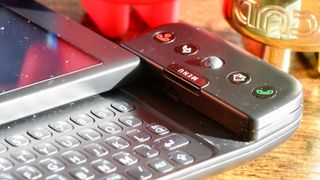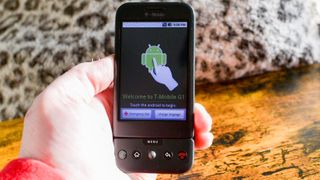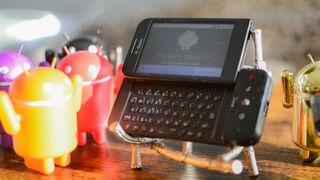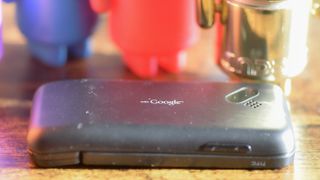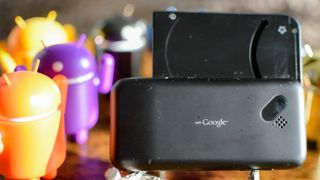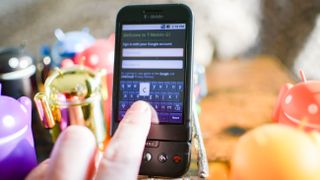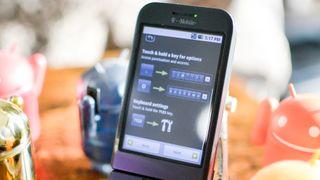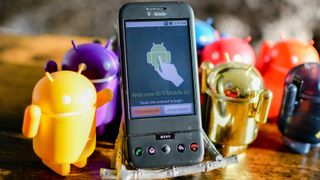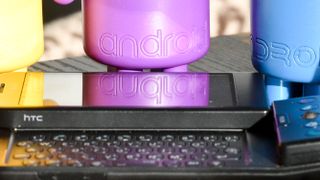The HTC Dream / T-Mobile G1 is fifteen years old as of September 23. This first Android phone was launched in 2008 as the Dream in Europe, then a few weeks later as the T-Mobile exclusive G1. Looking at the phone now, it’s symbolic of Android’s promise, and endemic of everything that has gone wrong since the Apple / Google duopoly of the smartphone world took hold.
For a while, if you wanted an Android phone in the US, you needed to go with T-Mobile, just as iPhone buyers were forced to use AT&T for the first four generations. Carriers wanted the best phones as exclusives, and phone makers were happy to oblige. That’s one of the many ideas and features that shaped this phone, proving just how much the phone world has changed.
I’d love to show you my T-Mobile G1 in action, because I still have it and it miraculously still holds a charge and powers on, even after fifteen years. I bought my phone on day one, even though I was also borrowing a review unit. I knew I wanted one to own and keep. It was so unique, and it still is, that it’s a standout in my collection.
Unfortunately, I can’t get past the activation screen. The T-Mobile G1 required an active SIM card to work. Then you need to log into your Google Account, or create a new one, or else you can’t use the phone at all. The SIM card it uses is an older version, and the cards have changed twice since then. I tried using my microSIM card in the T-Mobile G1, with an adapter, but alas, the phone from 2008 would not recognize my 2023 technology.
That’s okay, because the hardware itself is enough to marvel over. It’s such a compilation of bad smartphone ideas that it’s essentially the antithesis of everything we expect from the best smartphones today. Starting with that SIM lockdown, carrier exclusivity, and required Google login, it’s a relief that the smartphone world has learned so many lessons since the days of the first Android phone.
The HTC Dream had a keyboard, and that’s everything you need to know
The HTC Dream has a keyboard, and if that seems a strange decision, it would have been almost as strange in 2008 for this smartphone to launch without a keyboard. While the new iPhone was quickly catching on, Apple was still jockeying for second place behind the dominant smartphone maker, Research In Motion (RIM). You’ve probably heard of RIM’s popular phone brand: BlackBerry.
I saw an early prototype of the first Android phone well before it was launched, and it did not look like the HTC Dream. It looked like a BlackBerry. It was a flat slab with a screen on the top half and a keyboard on the bottom. It had function buttons between the screen and the keys. In total, it looked nothing like the HTC Dream, because Android was conceived to compete with BlackBerry. Then the iPhone came along.
I don’t need to explain what the iPhone did to smartphones. I can just hold up a BlackBerry on one end and an iPhone on the other with every other smartphone in between, and it looks like the famous March of Progress illustration showing the evolution of homo sapiens. We thought we were so smart using the BlackBerry and sending emails from our phones, but we were actually living in caves and wearing loincloths compared to today’s devices.
The HTC Dream was built by a company that specialized in Windows Mobile phones. HTC made a slew of carrier-branded pocket computers like the HTC Titan that could run Windows Mobile and came feature packed. They had sliding keyboards that hid (thickly) behind the display, and could even tilt slightly to sit up when open, like a tiny laptop.
It made sense for HTC to make a sliding keyboard phone, that was its specialty. The HTC Dream has a unique sliding mechanism that swings out in an arc. It feels more like a phone from the SideKick family (also a T-Mobile exclusive) than a professional Windows Mobile phone. Sadly, it also feels cheap compared to the more professional smartphones HTC made.
The keyboard keys are tiny. With plenty of practice, I was proficient typing on these tiny keys, but the little bubbles barely protrude above the surface of the bottom half. My Google password has become incredibly complicated since I bought this phone in 2008; it required slow, precise typing to enter it accurately.
That said, it’s kind of amazing to have a Shift button on a phone for capital letters. To be able to quickly tap Alt- and then a number to get the symbol I need. I miss it. I miss having real buttons, instead of just a touchscreen. I miss the unfussiness of a real keyboard. A keyboard is built for efficiency and work. A touch screen is made for elegant design. The two can often be at odds.
Actually, there were a LOT of buttons on the T-Mobile G1
Besides the touch screen, the HTC Dream also has hardware buttons, and WOW!, there are a lot of buttons. While Apple makes waves by adding a single Action Button to its iPhone 15 Pro lineup, the T-Mobile G1 / Dream has no fewer than 8 buttons, and that includes the trackball, which clicks like a button.
Yes, a trackball. There is a trackball on the HTC Dream. A ball that tracks, on a phone. A tiny little ball that you can roll around with your finger. This is still a touchscreen phone, so you are supposed to tap on what you want, but the ball is there in case you need another controller option.
Why was there a trackball on the first Android phone? Again, the answer is BlackBerry. The BlackBerry Pearl was the most popular BlackBerry phone when Android was being developed, and it came with an eponymous pearl trackball. Actually, the Pearl was a very cool phone, with a unique 20-key SureType keyboard, and a ball that could light up different colors for alerts. It’s no wonder that HTC and Android wanted to borrow some of that magic.
Still, it feels rather silly in today’s context. It’s a clear step backwards, arriving just as the touch interface concept was really taking off and getting better. In fact, most of the buttons on the HTC Dream slowly faded away as Android evolved, though I wish some would make a comeback.
The Dream has Send and End buttons for phone calls. You could also swipe on the screen, but people were too used to pressing a button to accept a call for Google to remove that option. Remember, most people were not coming from a smartphone to the T-Mobile G1. They were trading in a Motorola Razr or an old Nokia candy bar phone. Those phones need call buttons.
The other three buttons on the HTC Dream lingered far too long on Android phones, and can even be found on some Samsung models today as software buttons that Samsung glues to the bottom of the screen. Those are the Home, Menu, and Back buttons.
On the best Android phones today, all of those actions have been replaced with swipes. You swipe up from the bottom to go home. You swipe in from the side to go back. Instead of a menu button, Google encourages developers to make features easier to find on screen. The Menu button kept too many features hidden until you remembered to press it.
The iPhone launched with a Home button, and that’s it. There is no Back button on the iPhone, and there never has been. A Back button indicates a mistake. It’s an Undo button. A good mobile app needs to be designed with clear controls on screen, so the user doesn’t make mistakes that require them to go Back. At least, that seems to be the Apple philosophy.
There were a few great features on the HTC Dream
There is one button on the T-Mobile G1 that I wish modern phones retained: the camera button. The Action Button on the new iPhone 15 Pro can launch the camera (and take pictures), but I’ve never understood why modern smartphones don’t have a proper camera shutter button. The button on the HTC Dream / G1 can take photos, but I want even more than that.
Real cameras have a shutter button that has two stages. You press halfway until you feel some resistance, then the camera focuses on your subject. Once your shot is in focus, you press the rest of the way. There were old smartphones way back in the day that had this function – the Nokia N-Series of Symbian phones, for instance. I don’t know why this isn’t much more common.
Smartphones have become our point-and-shoot cameras. Nobody carries a camera if they have a good enough smartphone. The HTC Dream came with a 3.2MP camera, which was a premium shooter at the time. The iPhone 3G, the second iPhone, launched a few months earlier, had only a 2MP camera on board.
How did the T-Mobile G1 / Dream compare to the iPhone that would eventually become its biggest rival? Quite favorably, in fact. The original iPhone came out in 2007, so the HTC Dream was launched after Apple made its first major upgrade to 3G networking in its second generation device. The original iPhone didn’t even have GPS built-in, but the newer iPhone 3G wasn’t lacking that major feature.
Google Maps would be one of the best features of the T-Mobile G1 at launch. At the time, if your car didn’t have GPS, you could use a mapping app on your phone, but it would cost you. Even basic feature phones had GPS built in and could run Verizon’s VZ Navigator, for instance, but there was an expensive monthly fee for the service. Google Maps was free, you just pay for the data it uses. That was revolutionary at the time. Apple Maps was unproven, but Google Maps was an established brand.
Like the original iPhone, the iPhone 3G could not record videos with the camera. The HTC Dream had no trouble making movies, and it was all around a very competitive phone against the iPhone. The Dream had a faster processor, a sharper display (though a bit smaller), and a microSD card slot. It even had a removable battery, which was common on smartphones until the iPhone came along and ruined the party.
The T-Mobile G1 arrived at the most exciting time for smartphones
One thing the T-Mobile G1 didn’t have? A headphone jack. Yup, well before Apple wrongly decided to drop the oldest and most prolific port in all of consumer electronics, Google gave up its headphone jack in favor of a single mini-USB port. There were headphones in the box that would work with mini-USB. Reviewers complained, loudly, and later Google-branded Android phones brought back the ever-popular option.
The HTC Dream display uses Corning’s original Gorilla Glass, just like the iPhone 3G, and this was just the start of real phone durability. My fifteen year old phone has no scratches on the screen, though the plastic is a bit worn.
Of course, it would be Samsung, Android’s eventual champion, that introduced real water resistance to smartphones. That’s a feature I can’t live without, and neither should any phone owner. Today’s best phones are also made with the latest Gorilla Glass Victus, which Corning has demonstrated taking a fall onto concrete without breaking.
I switched from the original iPhone to the T-Mobile G1, and I’m probably one of the original switchers. I would soon come back to Apple with the iPhone 3GS, which is one of my favorite iPhone designs, even to this day.
I wouldn’t return to Android for a few years. The Palm Pre came along in 2009, stealing my attention, and it remains my favorite smartphone of all time. I wouldn’t find interest in the Android world again until Google and HTC collaborated on the Google Nexus One.v
That phone was stellar in design and superlative in features. It had a superfast processor and a high-resolution OLED display that was sharper than its iPhone competitor. Ok, it also had a trackball.
There was a sequel to the T-Mobile G1 called the T-Mobile G2, released two years later, only in the US. It was a fine phone, but by then Samsung had already upended the Android world with its Galaxy S devices. With rich OLED displays, blazing performance, and congruency across every mobile carrier and every country, it was easy to find yourself suddenly living in Samsung’s Galaxy, if you wanted to be an Android user.
The HTC Dream teaches us a lesson about chasing the competition
While the iPhone and the T-Mobile G1 may have been the progenitors of our current smartphone paradigm, it was Samsung’s Galaxy S phones that were the first to break carrier exclusivity. Before the Galaxy, you could choose your phone, but you’d be stuck with whatever carrier sold it. After the Galaxy launched, you could buy the phone you wanted on whatever network you choose.
Is there a lesson to be learned from the HTC Dream? I loved using the phone at the time, with its widgets and its extensive features. The menu button and the trackball may have been bad ideas, but they also meant there was more to find and more to do with the HTC Dream than there was with the iPhone. Even today, we find Android phone makers willing to risk bad decisions, simply to offer users much more than the competition.
In retrospect, it’s hard not to consider this phone a failure. Very few of its hardware ideas survived into modernity. We’ve given up on keyboards, on too many buttons, on removable batteries and chintzy plastic. The only idea we’ve kept is the HTC Dream’s worst – getting rid of the headphone port.
The problem is that Android and Google were chasing a moving target, and then the target changed. Google started out trying to make a better BlackBerry, then had to pivot to match the iPhone. Android has never fully gained a sense of direction. It has always been chasing competitors, even if Google’s competitors include the Android phone makers, as well.
The hockey legend Wayne Gretzky famously said “skate to where the puck is going to be, not where it has been.” It is clear that Apple’s iPhone is a vision of the future for mobile technology. Has Google ever had a vision for our smartphone future? Or has it been chasing, trying to catch the puck while others score goals? The next Pixel 8 phones, successors to the Nexus line, are coming soon. Hopefully we’ll find out where Google is going.

